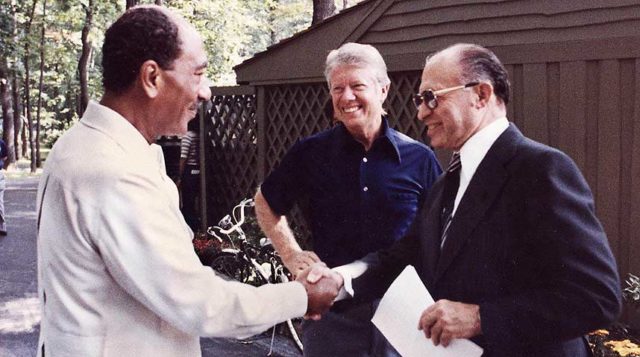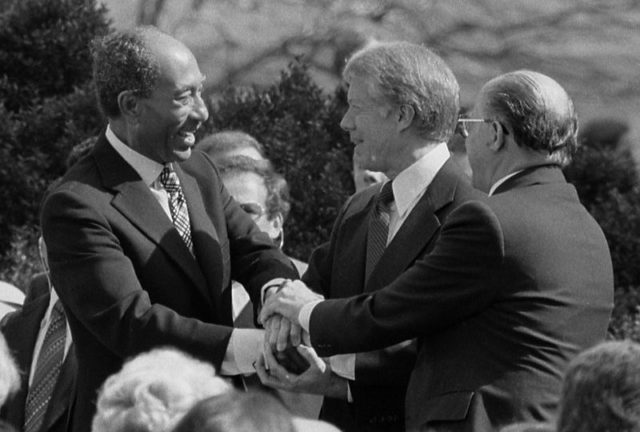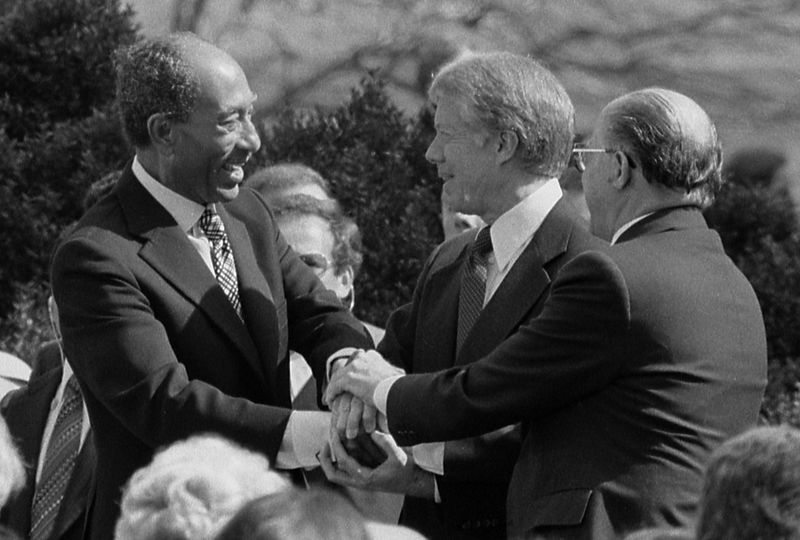In 1948, a coalition of Arab countries in the Middle East fought a bloody war to prevent to formation of the Israeli state. Eventually, Israel triumphed and an armistice agreement was signed, but none of the Arab nations recognized it as a sovereign state.
The Suez Crisis of 1956 saw a joint Israeli, British and French invasion of Egypt, which ensured relations between Israel and her neighbors remained icy cold. Tensions once again came to a head in the Six Day war of 1967, in which Israel defeated another coalition of Arab countries and made major territorial gains, which included taking the Golan Heights from Syria, the West Bank from Jordan and the Gaza Strip and Sinai Peninsular from Egypt. The Arab nations, including Egypt, remained hostile to Israel following the war, and still refused to give it recognition.
The Egypt–Israel Peace Treaty was signed in Washington, D.C., on 26 March 1979, following the 1978 Camp David Accords by Egyptian president Anwar Sadat and Israeli prime minister Menachem Begin, with United States President Jimmy Carter as a witness.

The peace treaty between Egypt and Israel was signed 16 months after Egyptian president Anwar Sadat’s visit to Israel in 1977 after intense negotiation. The eventual outcome of these talks, the “Framework for Peace in the Middle East,” had three parts: (1) a process for Palestinian self-government in theWest Bank and Gaza, (2) a framework for the conclusion of a peace treaty between Egypt and Israel, and (3) a similar framework for peace treaties between Israel and its other neighbours. The prime minister and the Israeli Knesset agreed that a transitional self-governing Palestinian authority was to be elected to replace Israeli political and military forces in the occupied territories.
The main features of the treaty were mutual recognition, cessation of the state of war that had existed since 1948 Arab–Israeli War, normalization of relations and the complete withdrawal by Israel of its armed forces and civilians from the Sinai Peninsula which Israel had captured during the Six-Day War in 1967. Egypt agreed to leave the area demilitarized. The agreement also provided for the free passage of Israeli ships through the Suez Canal and recognition of the Strait of Tiran and the Gulf of Aqaba as international waterways. The agreement notably made Egypt the first Arab state to officially recognize Israel.

The peace treaty that Israel and Egypt signed in March 1979 closely reflected President Carter’s proposals at Camp David and formally ended the state of war that had existed between the two countries. Israel agreed to withdraw from Sinai, and Egypt promised to establish normal diplomatic relations between the two countries and open the Suez Canal to Israeli ships (which until then had been banned from the waterway). These provisions were duly carried out. However, most Arab countries, rather than following Egypt’s lead, ostracized Egypt and expelled it from the Arab League. The Palestine Liberation Organization (PLO), professing to speak for the Palestinian people, also rejected the accords. On October 6, 1981, Muslim extremists assassinated Sadat in Cairo. Nevertheless, the peace process continued without Sadat, and in 1982 Egypt formally established diplomatic relations with Israel.
The next major advance in Middle East peace negotiations, the Oslo Accords, were signed by Israel and the PLO in 1993, included provisions with regard to the West Bank and Gaza that were similar to those in the Camp David Accords. These included a transitional period, an elected self-governing Palestinian authority, withdrawal of the Israeli military government and redeployment of Israeli troops, the establishment of a local police force, and a plan to move ahead with negotiations on the final status of the occupied territories.
